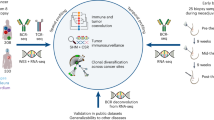Abstract
Anti-p53 antibodies in sera are known to be products of the host immune response to mutated p53 protein, and are present in some patients with various types of cancer. In this study, we measured serum anti-p53 antibody levels in 52 patients with lung cancer and 63 normal volunteers to determine the relationship between anti-p53 antibody level and clinical features of lung cancer patients. Anti-p53 antibody level was measured by an enzyme-linked immunosorbent assay and expressed as an anti-p53 antibody index, defined as the ratio of absorption of serum sample to that of p53-positive serum. The median anti-p53 antibody index was 6.6 for lung cancer patients, and higher than that in normal volunteers (1.7) (P = 0.0000). For lung cancer patients, significant differences in index levels were found by histology (4.3, n = 25, adenocarcinoma vs 8.7, n = 18, squamous cell carcinoma vs 64.8, n = 2, large-cell carcinoma vs 9.8, n = 7, small-cell carcinoma; P = 0.0109). High anti-p53 antibody index levels were observed for both large-cell carcinoma and small-cell carcinoma. When the cut-off level was set at 7.2, determined using the twice 95% specificity level for normal volunteers, the sensitivities of anti-p53 antibodies were 46.1% for all lung cancers, 28.0% for adenocarcinoma, 55.6% for squamous cell carcinoma, 100% for large-cell carcinoma and 71.4% for small-cell carcinoma. However, there were no significant differences in index level by gender, age, smoking index, presence of previous or concomitant cancer or disease stage. Multivariate analysis using a logistic regression model demonstrated that histological type of tumour was a dominant factor associated with elevation of anti-p53 antibody index level (P = 0.0184). These findings suggest that serum anti-p53 antibody index level might be independent of tumour burden and the presence of previous or concomitant cancer in our series of lung cancer patients, but is clearly strongly correlated with tumour histological type.
This is a preview of subscription content, access via your institution
Access options
Subscribe to this journal
Receive 24 print issues and online access
$259.00 per year
only $10.79 per issue
Buy this article
- Purchase on Springer Link
- Instant access to full article PDF
Prices may be subject to local taxes which are calculated during checkout
Similar content being viewed by others
Author information
Authors and Affiliations
Rights and permissions
About this article
Cite this article
Segawa, Y., Kageyama, M., Suzuki, S. et al. Measurement and evaluation of serum anti-p53 antibody levels in patients with lung cancer at its initial presentation: a prospective study. Br J Cancer 78, 667–672 (1998). https://doi.org/10.1038/bjc.1998.557
Issue Date:
DOI: https://doi.org/10.1038/bjc.1998.557



